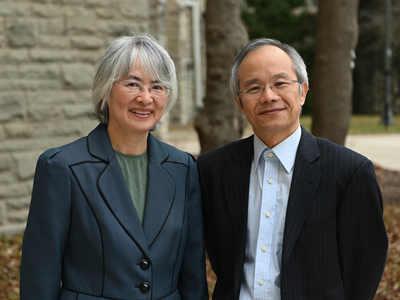In major breakthrough, researchers close in on preeclampsia cure
 Preeclampsia affects up to eight per cent of pregnancies globally and is the leading cause of maternal and fetal mortality due to premature delivery, complications with the placenta and lack of oxygen. (Envato Elements)
Preeclampsia affects up to eight per cent of pregnancies globally and is the leading cause of maternal and fetal mortality due to premature delivery, complications with the placenta and lack of oxygen. (Envato Elements)By Prabhjot Sohal
Researchers from Schulich Medicine & Dentistry and Brown University have made groundbreaking progress towards identifying the root cause and potential therapy for preeclampsia.
The pregnancy complication affects up to eight per cent of pregnancies globally and is the leading cause of maternal and fetal mortality due to premature delivery, complications with the placenta and lack of oxygen.
The research, led by Drs. Kun Ping Lu and Xiao Zhen Zhou, and Drs. Surendra Sharma and Sukanta Jash at Brown, has identified a toxic protein, cis P-tau, in the blood and placenta of preeclampsia patients.
According to the study published in Nature Communications, cis P-tau is a central circulating driver of preeclampsia – a “troublemaker” that plays a major role in causing the deadly complication.
“The root cause of preeclampsia has (so far) remained unknown, and without a known cause there has been no cure. Preterm delivery is the only life-saving measure,” said Lu, professor of biochemistry and oncology, and the Western Research Chair in Biotherapeutics.
 A new study by Drs. Xiao Zhen Zhou (L) and Kun Ping Lu is the first to identify cis P-tau, a toxic protein, in the placenta and blood of preeclampsia patients. (Schulich Medicine & Dentistry photo)
A new study by Drs. Xiao Zhen Zhou (L) and Kun Ping Lu is the first to identify cis P-tau, a toxic protein, in the placenta and blood of preeclampsia patients. (Schulich Medicine & Dentistry photo)
“Our study identifies cis P-tau as a crucial culprit and biomarker for preeclampsia. It can be used for early diagnosis of the complication and is a crucial therapeutic target,” said Sharma, professor of pediatrics (research) and professor of pathology and laboratory medicine (research) at Brown.
In 2016, Sharma, a leading preeclampsia researcher, and his team identified that preeclampsia and diseases like Alzheimer’s had similar root causes related to protein issues. This new research builds on that finding.
Until now, cis P-tau was mainly associated with neurological disorders like Alzheimer’s disease, traumatic brain injuries (TBI) and stroke. This association was discovered by Lu and Zhou in 2015 as a result of their decades of research on the role of tau protein in cancer and Alzheimer’s.
An antibody developed by Zhou in 2012 to target only the toxic protein while leaving its healthy counterpart unscathed is currently undergoing clinical trials in human patients suffering from TBI and Alzheimer’s disease. The antibody has shown promising results in animal models and human cell cultures in treating the brain conditions.
The researchers were curious whether the same antibody could work as a potential treatment for preeclampsia. Upon testing the antibody in mouse models they found astonishing results.

(Dr. Sukanta Brown/Brown University)
“In this study, we found the cis P-tau antibody efficiently depleted the toxic protein in the blood and placenta, and corrected all features associated with preeclampsia in mice. Clinical features of preeclampsia, like elevated blood pressure, excessive protein in urine and fetal growth restriction, among others, were eliminated and pregnancy was normal,” said Sharma.
Sharma and his team at Brown have been working on developing an assay for early detection of preeclampsia and therapies to treat the condition. He believes the findings of this study have brought them closer to their goal.
Black and Hispanic women more susceptible
 American track and field athlete Tori Bowie (centre) died in April 2023 due to a severe form of preeclampsia. (Erik van Leeuwen/Wikipedia)
American track and field athlete Tori Bowie (centre) died in April 2023 due to a severe form of preeclampsia. (Erik van Leeuwen/Wikipedia)
The tragic death of American track and field champion Tori Bowie earlier this year put the spotlight on preeclampsia, which disproportionately impacts Black and Hispanic women.
A gold, silver and bronze medalist in the 2016 Olympic Games, Bowie, 32, was found dead in her bed on May 2, 2023, while approximately eight months pregnant. According to the autopsy report the complications may have involved eclampsia—a severe form of preeclampsia.
“Research has shown that women of certain races have genes that could possibly lead to higher than average blood pressure levels, eventually creating conditions for preeclampsia during pregnancy. However, it’s also true that in many low socio-economic countries there’s no registry to record PE cases. So, its link to other environmental factors is still unclear,” said Sharma.
Preeclampsia and the brain
Recent research has also thrown light on preeclampsia’s long-term impacts and possible links to brain health.
“Preeclampsia presents immediate dangers to both the mother and fetus, but its long-term effects are less understood and still unfolding,” said Sharma. “Research has suggested a heightened risk of dementia later in life for both mothers who have experienced preeclampsia and their children.” However, the causal link between preeclampsia and dementia is not known.
The researchers say this new study has pinpointed a potential underlying cause of the complex relationship between preeclampsia and brain health.
“Our study adds another layer to this complexity. For the first time, we've identified significant levels of cis P-tau outside the brain in the placenta and blood of preeclampsia patients. This suggests a deeper connection between preeclampsia and brain-related issues,” said Jash, the lead author of the study.
As researchers delve deeper, how our bodies respond to stress is also emerging as a potential factor in the onset of preeclampsia.
“Although genetics play a role, factors like stress could be an important piece of the puzzle. Understanding how stress and other environmental factors intersect with biological markers like cis P-tau may offer a more complete picture,” said Jash, assistant professor of molecular biology, cell biology and biochemistry (research) and pediatrics (research) at Brown.
A stress-response enzyme called Pin1
In 1996 and 1997, Lu and Zhou made the groundbreaking discovery of Pin1, a stress-response enzyme. This is a specific protein in the cells that becomes active or changes its behaviour in response to stressors, such as environmental challenges, toxins or physiological changes.
“Pin1 plays a pivotal role in keeping proteins, including the tau protein, in the functional shape during stress. When Pin1 becomes inactivated, it leads to the formation of a toxic, misshapen, variant of tau – cis P-tau,” said Zhou, associate professor, pathology and laboratory medicine at Schulich Medicine & Dentistry.
Interestingly, Pin1 is a key player in cancer signalling networks, turning on numerous cancer-causing proteins and turning off many cancer-suppressing ones. Found in high levels in most human cancers, it's particularly active in cancer stem cells, which are thought to be central to starting and spreading tumors and are hard to target with existing treatments.
“Essentially, when Pin1 is activated, it can lead to cancer. On the other hand, when there's a decrease or deactivation in Pin1, it results in the formation of the toxic protein cis P-tau, which leads to memory loss in Alzheimer’s and after TBI or stroke. Now, we’ve uncovered its connection to preeclampsia as well,” said Zhou.
“The results have far-reaching implications. This could revolutionize how we understand and treat a range of conditions, from pregnancy-related issues to brain disorders,” said Lu.
Lu and Sharma met at Brown in 2019, where Lu was invited to give a lecture on his research. Following an engaging session and a few dinners together, a collaboration between the researchers was forged.
“Science surprises us. I had never thought of working on finding a therapy for preeclampsia. It also shows that a collaboration can be transformative.”








